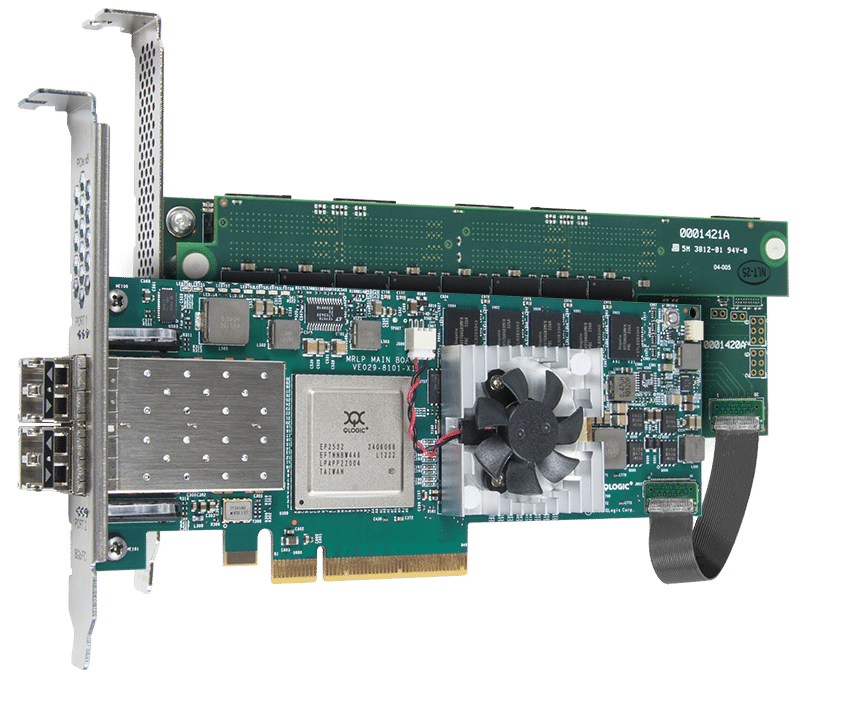
A popular industry trend is to utilize ultra fast flash drives to cache data on servers for faster access for demanding business applications. Qlogic has gone a step further than most by having the data cached by these flash devices across a pool of servers on the SAN. FabricCache transforms a single-server captive cache into a resource that can be tapped by multiple servers that support a wide variety of enterprise applications. Last year QLogic began showing the technology off as Mt. Rainier, today’s announcement provides more detail on the first product in this family, the FabricCache QLE10000.
Based on a standard Fibre Channel adapter, Qlogic’s FabricCache QLE10000 has SSD storage running at 8Gbps to accelerate the server I/O access. By using a single driver the caching process is offloaded to the adapter and minimizes the impact on the server in regard to CPU cycles and server memory. Moving the activity for I/O to an off board adapter has been a method utilized for many years to enhance performance of the channel while keeping host demands lower. Qlogic has designed this offering based on industry standard PCIe SSD drives and Fibre Channel SAN adapters to maximize compatibility while keeping overall deployment costs down. Initial release of the SAN adapter will have 200 GB and 400 GB of SSD cache, though vendor and flash configuration were not disclosed.
One of the most attractive qualities of the FabricCache technology is the simplification of deployment by essentially being transparent to existing SAN infrastructure, software drivers, or management framework. This means that the enhanced performance of this architecture can be added on without major impact to existing server and SAN environments, which minimizes down time and potential risks in deployment. With respect to the interoperability of existing management frameworks, plug-ins will be available for VMware, MS Hyper-V, and Xen server.
Unlike standard Fibre Channel SAN adapters, Qlogic FabricCache adapters are in constant communication with each other, providing cluster and cache management across multiple server nodes. Each adapter identifies a cache owner for a LUN on the SAN, and since all adapters are aware of this relationship the I/Os are redirected to the cache owner for that specific LUN. This greatly enhances scalability by allowing a single copy of cached data to support multiple servers and applications, which maximizes the utilization of the SSD drives and hence lowers TCO.
In performance tests with 250 users (TCP-E), a single server with no cache was able to yield only 74 transactions per second (TPS), while a server with a shared cache did 544 TPS, an increase of 7 times the transactions. With multiple servers the FabricCache technology really shines: 4 servers with no cache did 87 TPS, a meager amount of only 7 more TPS than one server. But with the FabricCache GLE10000 adapters and shared cache the same 4 servers were able to deliver 1,925 TPS, a whopping increase of over 22 times.
In a test using a 2 node Oracle RAC cluster (11gR2 11.2.03) with 1000 users:
- 82% faster peak response times
- 87% reduction in disk IOPS (demand on array)
- 57% reduction in average transaction times
On a Microsoft SQL Server 2008 the performance almost tripled in throughput when comparing non-cached to cached performance (120 Mbps vs. 350 Mbps).
To summarize, the Qlogic FabricCache technology provides a leap for distributed environments whether discrete or virtual and exhibit the following qualities:
- Fibre Channel adapter and cache consolidation
- Transparent cache for simplified deployment and management
- Cache sharing across multiple servers and applications
- Application performance with no change to SAN infrastructure, S/W drivers, or Management frameworks

